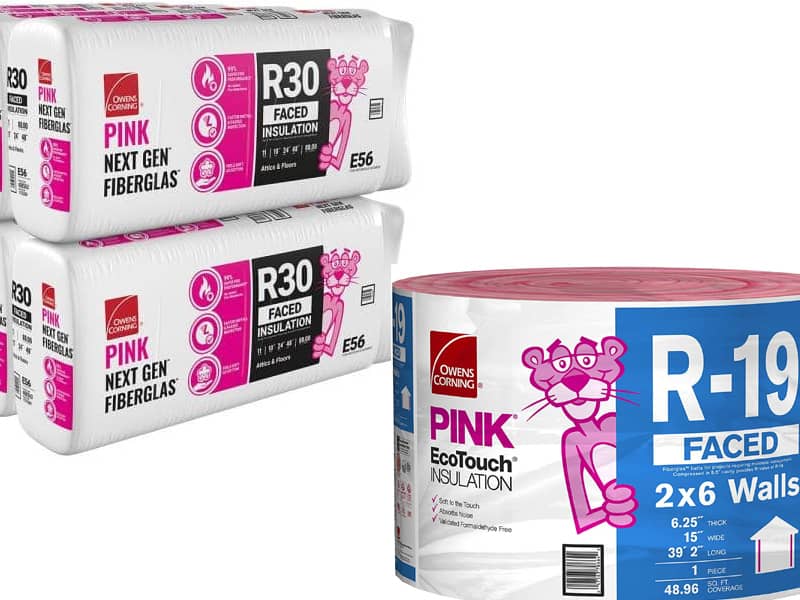In the construction business, understanding an R-value is crucial. The factor tells us how effective a wall or partition in your home will be when considering it as an insulation barrier.
Architects recommend having a higher R-value when it comes to having well-insulated homes. The higher the R-value, it will provide better insulation than ordinary ones.
Sometimes we also refer to the R-value as the thermal resistance value in scientific terms.
An effectively working insulation keeps your space from being affected by cold air entering your warm air homes or losing air conditioning in hot weather.
Insulation of higher R-value means that the home is insulated, keeping in mind all the architectural facts and covers all loopholes that allow weather from the outside to affect the house, making it a more comfortable place to live.
Comparing R19 vs R30 Insulation
People usually ask what makes R19 vs R30 insulation better. To decipher the question, let us understand how different R-values work.
So far, we understand that a higher value of R means that there will be better insulation in our homes. There will be better resistance between cold and hot areas as less heat flux gets through the barrier if the R-value of the insulating material is higher.

However, it is important to understand that experts suggest these different thermal resistance values purposely for use in varying capacities.
Effective insulation starts from an R-value higher than 12. The more advanced levels of resistance mean better control of heat flow.
Using the correct R-value at the correct place is necessary to get a well-insulated place that provides better control on energy bills.
Which is Better?
The DOE (Department of Energy) has various standardized R-levels of insulation that architects use in various places in our homes. These R-values differ in effectiveness and resistance to thermal conduction.
Moreover, these R-values are strategically placed in homes and offices and underground depending on the wall or surface’s exposure to higher temperature differences.
Although experts claim that higher R or thermal resistance values are better, we disagree with the statement wholeheartedly.
We believe a different R-value must be used in different places throughout the house to prevent airflow into and outside the space.
All areas of the house that come in contact with the external climate must be well-insulated using the correct R-value of padding or insulation.
There is no scientific reasoning to do one part of the house and leave another without proper treatment to assist in protection from temperature changes.
Imagine spending tons of money on air conditioning units to combat the hot or cold temperatures outside and then losing the temperature to the surroundings instead of maintaining it with the help of proper insulation. Let’s look at which type of R-value is better for which place in the house.
Walls
Think about how much we spend on making our homes comfortable places to live in by turning on air-conditioning units, hence paying extra to foot the energy bills.
If there is effective insulation on the walls of houses and work spaces, the temperature will remain constant on the inside. The high temperature from the outside will make a lesser impact on the inside.
Insulation of R-values 13 to 23 is though best for the walls. A wall with enough thickness and density to justify an R-value within this range will slow heat transfer. We can install R19 insulation on the exterior walls of our home to resolve this issue for good.

The insulation we put in our homes to prevent temperature change must be thicker enough to serve the purpose.
The insulating materials with an R19 thermal resistance value will be 6.25 inches thick. The thickness of this strength works best for walls to establish a desired temperature within the home.
Experts believe that the most air in our houses releases through the walls, windows, and doors. If one takes special care in sealing these spaces tightly, we can avoid a major portion of temperature change. The drafts in between walls are covered easily with the help of R19 insulation on the outer side of the walls.
Ceilings
As we move from the floor to the ceiling of a house, the R-value gradually increases. The house flooring requires less thermal resistance because there will be very little heat loss. Walls take up R19 resistance to save the temperature you have maintained from escaping.
When we talk about ceilings and attics above the houses, they can assist in a higher temperature loss if one does not take preventive measures.
Experts recommend that we install insulation of at least R30 or higher value in ceilings and attics. The insulating foam or other material used in the attic must come up to the level of the joists in the ceiling.
If you have an unfinished attic in the house, we recommend that you also insulate the attic floor to provide additional protection against heat loss.
R30 insulation is 9.5 inches thick and will save the preserved temperature from escaping when sun rays fall directly on the roof. If you live in extreme weather conditions, we advise you to adjust these R-value levels according to your climate. Add another couple of inches of insulation in very hot or cold areas.
Installing the Correct R-Value
We have compared R19 vs r30 insulation and know which is better than the other. However, we must also understand that installing the padding with the correct R-value is a crucial step. It will not only save you on energy bills but also increase the life of your home.
The correct R-value will save the exterior of the walls from the harmful effects of the extreme weather throughout the year, resulting in the longevity of your home. We recommend choosing the insulation with proper thickness and higher thermal resistance value.
We have seen people going overboard with the insulation in their homes and picking an R-value insulation much higher than the one they need. In such a situation, the thick padding will accumulate moisture, and mold will also be in the space over time.

Choosing the correct R-value is as important as choosing the right insulation material. So many options in the market make it difficult to decide what to choose. One must decide on a cost-effective material that provides the best insulation.
Unnecessary insulations will prevent the necessary airflow in the house that technicians refer to as breathing of the house. Putting too much padding will seal the house, making breathing difficult.
Experts’ Advice
It is always best to seek the advice of a professional expert when it comes to a matter as important as adding insulation to your home.
A trained technician will guide you better on which material to use for insulation in your home or office.
They will guide you about which R-value will be better for which areas of your house and whether you require an extra layer to top off the recommended R-value, depending on your climate.
Experts suggest a space of 1 to 2 inches between the insulation and walls or roof. Better spacing improves airflow throughout the house. Leaving a good enough space helps the house “breathe” so you do not feel trapped inside.
Installing the correct R-value insulation in your homes will help you combat heat loss, but there are many different types of insulating materials that you can use.
The expert you hire will also help you to choose the best possible solution according to your needs to get the best insulation in your house.
Conclusion
When we differentiate R19 vs R30 insulation, the higher insulation R-values mean that the isolation we put in place has a higher density and is thicker to provide better protection.
In return, you get better home temperature control and can help keep the energy cost low because the air conditioning inside the house will not work on overload to compensate for the air moving in and out of your house.
We hope that by now, you must have understood the concept and will make a rational decision regarding insulation.



